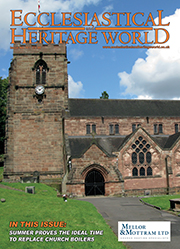Young people shun future visits to heritage attractions over coronavirus fears
 Research commissioned by specialist heritage insurer, Ecclesiastical, has revealed young people are less likely to visit heritage attractions in person once the lockdown lifts due to coronavirus fears. However, digital is a revenue opportunity for heritage attractions as two fifths (44%) of young adults who visited a heritage attraction online during lockdown said they would be willing to pay to access these if they were no longer free.
Research commissioned by specialist heritage insurer, Ecclesiastical, has revealed young people are less likely to visit heritage attractions in person once the lockdown lifts due to coronavirus fears. However, digital is a revenue opportunity for heritage attractions as two fifths (44%) of young adults who visited a heritage attraction online during lockdown said they would be willing to pay to access these if they were no longer free.
Young Brits are disengaged with the UK’s heritage
Before the coronavirus lockdown, many young adults in the UK aged 18-30 were disengaged with heritage. During the 12 months before the lockdown started most never visited stately homes (73%), galleries (66%), castles (61%) or theatres (53%) and 46% never visited museums (46%).
However the situation is set to get worse as the lockdown lifts as young people have said they are even less likely to visit heritage attractions in person after the lockdown lifts.
Worryingly, a third (30%) said they are less likely to visit theatres in person post lockdown. A significant proportion of young adults are also less likely to visit stately homes (28%), galleries (27%), castles (24%) and museums (23%).
Coronavirus fears deter young visitors
Those who are less likely to visit heritage attractions after the lockdown lifts are concerned that even if they are told it is safe, there will be too many people visiting and they will risk catching coronavirus.
Of those who are less likely to visit, young people are most concerned about the risks of catching coronavirus while going to the theatre (68%). 65% are less likely to visit museums and 60% are less likely to visit galleries due to concerns there may be too many people and they may risk catching coronavirus. While 56% are less likely to visit castles and 55% are less likely to visit stately homes because of this concern.
Heritage attractions have struggled to engage a captive audience during lockdown
Most digital heritage attractions such as online galleries, virtual museum tours and live streamed theatre performances have been freely available to the public during lockdown.
Despite this, the vast majority of young people have not visited stately homes (89%), castles (88%), galleries (86%), museums (83%) or theatres (80%) online during lockdown.
However, of those who did visit an attraction online during the coronavirus lockdown the vast majority described the digital experience as excellent or good when visiting museums (86%), theatres (76%), castles (75%), galleries (71%), and stately homes (66%) online.
Heritage attractions need to promote themselves better and improve their digital offering to engage young people
Heritage attractions need to better advertise their online attractions as a third (32%) of young people surveyed said they weren’t aware it was possible to visit heritage attractions online.
Half (48%) agree that heritage attractions need to improve their online presence and that heritage attractions with a good digital offering inspire them to want to visit in person (46%).
The top 3 things young people would like heritage attractions to offer are:
- Virtual tours (39%)
- Virtual events (31%)
- Social media Q&As (30%)
Digital is a revenue opportunity for heritage attractions
The research found that two fifths (44%) of young adults who visited a heritage attraction online during lockdown said they would be willing to pay to access a heritage attraction online if these were no longer free to view after lockdown.
Of those who would be willing to pay, six in ten (63%) would pay a small donation while 43% would pay a membership subscription to access these online experiences. Young people said they would be willing to pay because they value the experience (57%), they want to support the attraction financially (54%), they enjoy the experience (34%), and it would cost them more if they had to travel to the venue (14%).
The National Theatre is a great example of a heritage attraction that has adapted during the coronavirus lockdown. The theatre broadcast some of its most popular productions for free via YouTube as part of its National Theatre at Home initiative. The British Museum has been uploading images of its collection online during the coronavirus pandemic to give people a way to access artefacts digitally during lockdown, while a photography exhibition at the National Portrait Gallery that never opened because of coronavirus was turned into a virtual reality experience.
Faith Kitchen, heritage director at Ecclesiastical said: “As the UK’s leading insurer of Grade I listed buildings in the UK, we’re passionate about protecting Britain’s heritage. It’s sad to learn that some young adults today are even less likely to visit heritage attractions in the future than ever before due to coronavirus fears. While many heritage organisations have worked hard to offer digital experiences such as online galleries, virtual museum tours and live streamed theatre performances during lockdown, clearly more needs to be done to advertise to and engage young people.
“The coronavirus is having a major impact on heritage organisations and many are facing financial difficulties. We recognise that it’s an incredibly challenging time for the sector so it’s really encouraging to read that two fifths (44%) of young adults who visited a heritage attraction online during lockdown said they would be willing to pay to access a heritage attraction online if these were no longer free to view after lockdown. However, it’s also interesting to see that a third (32%) of young people weren’t even aware it was possible to visit heritage attractions online. Raising awareness seems to be a huge hurdle for organisations yet our research shows that prioritising spend or gaining funding for digital initiatives may support engagement with a younger audience and provide new revenue streams.”
For further information visit www.ecclesiastical.com
















